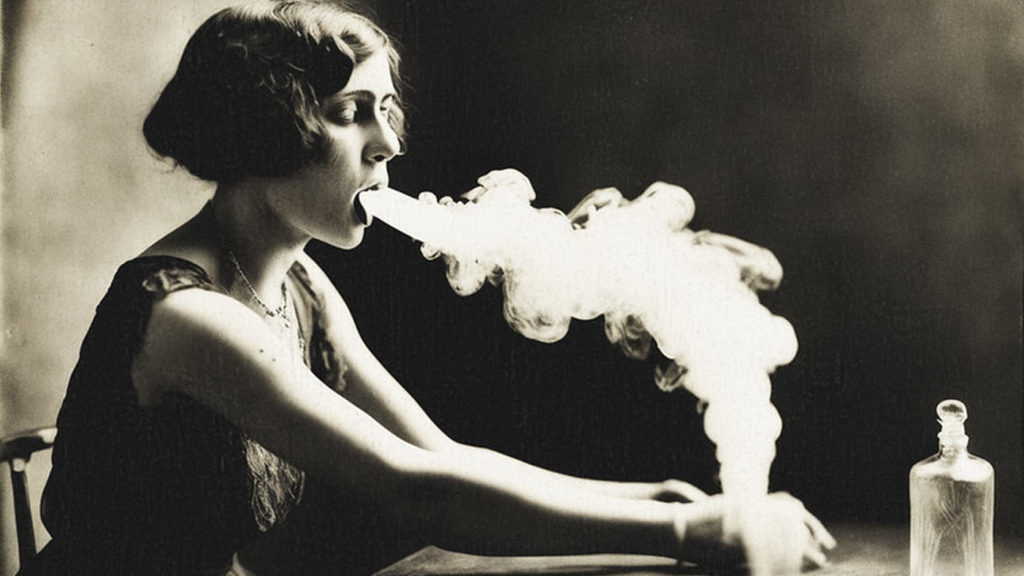For the sake of completeness, we now come to the last topic I wish to discuss about the functioning of the etheric envelope. That topic is about ectoplasm, which comes from the Greek ektos, meaning outside and plasma, meaning mould, i.e., that which is moulded outside the human body. This is the name given to the matter, mainly if not wholly etheric, which exudes from a medium and is employed for séance-room phenomena. The fascination of the Spiritualist movement for the séance, with the central role played by the medium, is no longer in vogue. It played a major role in bringing to people’s attention that there were paranormal phenomena that could be viewed and documented. While this may not have spread to the masses and a good thing too, it did influence intellectuals who went on to communicate a more favourable view of other esoteric ideas that had their origins in India and were initially popularised by the Theosophical Society.
W.J.Crawford, in his books (The Reality of Psychic Phenomena (1916), Experiments in the Psychical Science (1918), and Psychic Structures (1921) ), described the research he undertook into such phenomena as table-lifting, or “levitation”, and rapping. These were phenomena that were witnessed when a medium, who was always fully conscious, was able to liberate ectoplasm from their etheric envelopes, supported to a lesser degree by other participants in the séance.
Crawford approached the problems of table-lifting, etc., purely as problems of mechanics and, employing equipment, which could measure force, both mechanical and electrical, he succeeded in discovering, by deduction from his observations, the modus operandi of the “psychic structures” employed. Those structures are the ejection of ectoplasm and their attachment to objects. At a much later stage, he was able to verify his deductions by direct etheric vision and by photography.
It was found that the ectoplasm, exuding from the medium, was prepared and shaped by the “operators” who control the production of the phenomena, into what he terms “rods”. These rods or bars were attached at one end to the medium and at the other, by suction, to table-legs or other objects. At this stage, psychic force was applied through the rods to objects such as tables, moving them in various ways, without any physical contact with any person present. Rapping sounds were also produced when these rods struck the floor or hit an object like a bell.
The greatest portion of the ectoplasm materialised in a séance was usually obtained from the medium, though this was supplemented by other sitters present. The ectoplasm was sometimes felt. This was despite the fact that it was invisible. It was described as being clammy, cold, reptilian, almost oily, as though the air were mixed with particles of dead and creepy matter. The etheric rods issuing from the medium varied in diameter at their extremities from ½ inch to 8 inches and the free end of each rod seemed able to assume various shapes and degrees of hardness. The end could be flat or convex, circular or oval; it was sometimes soft as the flesh of a baby, or as hard as iron. The body of the rod felt solid, a few inches from the free end, but then became intangible, though it resisted when it was pulled or, pushed. It could be sheared and exhibited torque.
In the intangible portion between the medium and the tip, a flow of cold, spore-like particles could be felt, the flow coming from the medium. There appeared to be a complete circulation of etheric matter out from the medium and back to her again at a different part of the body. This was not the case in a complete levitation of an object.
Crawford considered it probable that the rods consist of a bundle of fine threads, intimately connected and adhering to one another. The psychic force, as it was termed, passed along the threads, stiffening the whole structure into a rigid girder, which was then moved as desired, by forces applied within the body of the medium. Experiments seemed to indicate that the end of a rod consisted of a thick and more or less elastic film or skin, stretched over a thin, somewhat serrated, elastic frame. The elasticity of the film was limited and if too highly stressed the film ruptured, leaving the serrated frame exposed. This must have been spooky, yet fascinating to observe. These were all parlour tricks. I wonder what the investigators at the time thought the value was for medium to have such abilities?
The fact that an electroscope, which was a machine to measure electricity, could be discharged by being touched by a rod indicated that the rod acted as a conductor of high voltage electricity, discharging to earth through the medium’s body, to which it is attached. On the other hand, a rod placed across the terminals of a bell circuit did not cause the bell to ring, thus showing that it offered high resistance to low-voltage currents. One thing that was noted was that white light usually destroyed rod formations, including reflections of light. Red light, however, if not too strong, did not appear to injure the etheric structure and neither did light emanating from luminous paint.
In the case of the movement of objects, two principal methods were employed. In the first, one or more rods were projected from the medium, very frequently from the feet or ankles, sometimes from the lower part of the trunk and were attached directly to the object to be moved, thus forming cantilevers, i.e., it was only attached at one end. When tables are moved horizontally, the rods are usually attached to the table legs; where they are lifted into the air, the rod or rods are often spread out like a mushroom at the ends and attached to the undersurface of the table. It is almost like having an extended robot arm.
In the second method, the rod or rods projecting from the medium were attached to the floor and from the point of attachment they continued to the object to be moved, thus no longer forming a cantilever but a fulcrum, between the weight to be lifted and the power source, the medium. If a medium used the cantilever method to raise a table, it was noted that the weight of the medium increased by 95% of the weight of the table. When, on the other hand, the rods were attached to the floor using the fulcrum method, the weight of a levitated table was transmitted directly to the floor and the medium’s weight, instead of being increased, was decreased, the decrease being due to the weight of the excreted ectoplasm forming the rod, one end of which rested on the floor. The method to be employed when lifting an object, cantilever or fulcrum, would be determined by the weight of the object.
During levitation of objects, the stress on the medium was often apparent in the stiffness and even iron-like rigidity of the muscles, principally of the arms, but sometimes all the muscles in the body. Later this was not observed, why, we can only guess. The production of these phenomena appeared to result in a permanent loss of weight, both of mediums and sitters, but only by a few ounces. I suspect this could just have been attributed to sweating.
Inserting an object between the medium and the object being moved caused the rod to fail. If the rod was partially pierced by a pencil, then it remained intact. Breaking such connections between a medium and an object could be injurious to them.
In general, the production of these etheric phenomena throws stress on all the sitters at the séance. They experienced spasmodic jerks, sometimes quite severe, which went round the whole circle, just before the levitation of an object. It would appear that the process of loosening and removing etheric matter from the bodies of the sitters occurred spasmodically and affected them all at once.
Crawford was convinced that in the production of séance-room phenomena, there are at least two substances employed : (1) a component, forming the basic part of the psychic structure, which is invisible, impalpable, and generally outside the range of physical things altogether, and (2) a whitish, transparent, nebulous substance, which allowed the ectoplasm to connect to physical objects. The substance emanated from the whole body of the medium, but especially from the natural orifices and extremities, from the top of the head, the breasts and the fingertips. The most usual origin and most easily observed, is the mouth, the inner surface of the cheeks, the gums and the roof of the mouth.
The materialised forms have a certain independence, a hand, for example, being able to move its fingers and grasp the hand of the observer, though sometimes the human skin seems to repel the phantoms. The structures, such as fingers, are sometimes smaller than in nature. The back of the materialisations has been observed to be without organic form, being merely a mass of amorphous substance, the forms containing a minimum of substance necessary to make them appear real. The forms may disappear very gradually, fading away, or almost instantaneously. During the whole time, it is clear that the forms are in physiological and etheric connection with the medium, the sensation reflex of the structures coalescing with that of the medium. Thus, a pin inserted into the substance would cause pain to the medium.
On that gory note, let’s forget about ectoplasm and go on to conclude our look at the etheric envelope in the next presentation.


